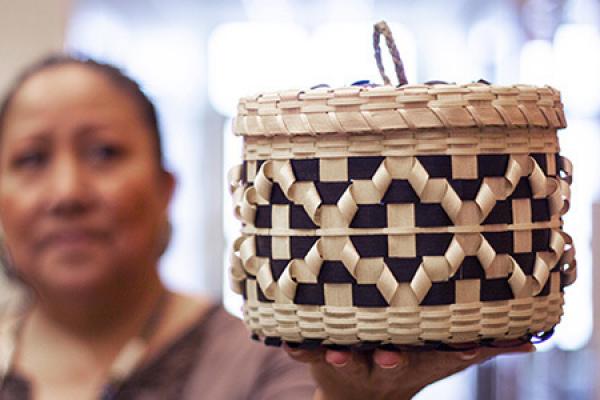Pokagon Potawatomi Black Ash Baskets: Out Storytellers

(Chicago, ILLINOIS, March 22, 2021) --This April, a new exhibit will open at the Field Museum that explores the artistry, tradition and the importance of basketmaking among the Pokagon band of the Potawatomi people. For the Pokagon Potawatomi, these baskets are regarded with the utmost honor, treated as living members of the community. However, over the past century, the practice of basket weaving has been threatened; first by the enforcement of oppressive government regulations and now by the ecological threat presented by the Emerald Ash Borer. This exhibit tells a story of survival and resilience of the Pokagon Potawatomi. But it also contains a cautionary tale and a warning of environmental catastrophe.
For centuries, baskets have been an important part of Pokagon life. Historically they were used for storage, to contain food, fibers and collect berries. These baskets have always had important roles to play in their communities. However, as the Federal Government claimed lands from Native American tribes it also enforced a set of laws that stripped these communities of their rights to continue cultural practices. Communities had to be recognized as a tribe by the Federal Government which was a feet that required much momentum and perseverance. The Pokagon sought federal recognition in the 1930s, but the energy for this movement dwindled. For decades, the cultural identity of the Pokagon Potawatomi weakened. Basket weaving was nearly lost until Agnes Rapp and Juliae Wesaw began a co-op that reintroduced the Pokagon to the art of basketmaking. Thanks to the co-op reinforcing the importance of maintaining these traditions, the movement for federal recognition was re-energized. Finally in 1994, the Pokagon Potawatomi won their fight for sovereignty.
Today, basketmaking remains an important part of the cultural heritage for the Pokagon Potawatomi. It is a tradition passed from one generation to another. “The Pokagon Potawatomi peoples are familiar with the traditions of our ancestors and know the multiplicity of stories within baskets. The baskets — assumed silent, static, and lifeless — speak to many of us,” says Dr. John Low, the exhibit’s co-curator.
Now Pokagon basket making faces a new threat, the Emerald Ash Borer. Black Ash trees provide the wood needed to create these baskets. In the 1990s, the emerald ash borer, a beetle native to northeastern Asia that feeds on ash trees, found its way to the U.S aboard shipping crates. With no natural predators, the emerald ash borer is an invasive species, and highly destructive. Since it arrived, it has destroyed over 60 million ash trees. This begs the question, what will the Pokagon do without Black Ash trees? Will the tradition of basketmaking be lost as the trees perish?
For the Pokagon Potawatomi people, these baskets have souls and stories to tell. “The hands heard weaving are the same hands that make bread and plant seeds for food. Seeds of knowledge and wisdom are also planted with those busy hands,” says Dr. John Low. “Stories emanate from the baskets. Like the songs, prayers, and plantings of our grandmothers, we hear those stories. Because we know to listen. We know the songs the baskets sing. We listen, and smile, and say a prayer of gratitude.”
Pokagon Potawatomi Black Ash Baskets: Our Storytellers opens to the public on Friday, April 16th in the Marae Gallery at the Field Museum. The exhibit will feature handmade baskets by prominent members of the Pokagon Potawatomi tribe, a media piece that features Agnes Rapp and other basket makers at work and Emerald Ash Borer specimens. This exhibit is free with the cost of museum admission and open to visitors of all ages. It will be on display for the public until February 20, 2022.
